Total Hip Replacement: Case Study Assessment
VerifiedAdded on 2023/04/11
|11
|2866
|68
AI Summary
This case study assessment explores the process of total hip replacement, including the anatomy, etiology, pathophysiology, clinical manifestations, evidence-based treatment care, nursing process care, and holistic care plan.
Contribute Materials
Your contribution can guide someone’s learning journey. Share your
documents today.

Right Total Hip Replacement
Case study Assesment
University
Name
Unit
Tutor
Date
ASSIGNMENT
Case study Assesment
University
Name
Unit
Tutor
Date
ASSIGNMENT
Secure Best Marks with AI Grader
Need help grading? Try our AI Grader for instant feedback on your assignments.
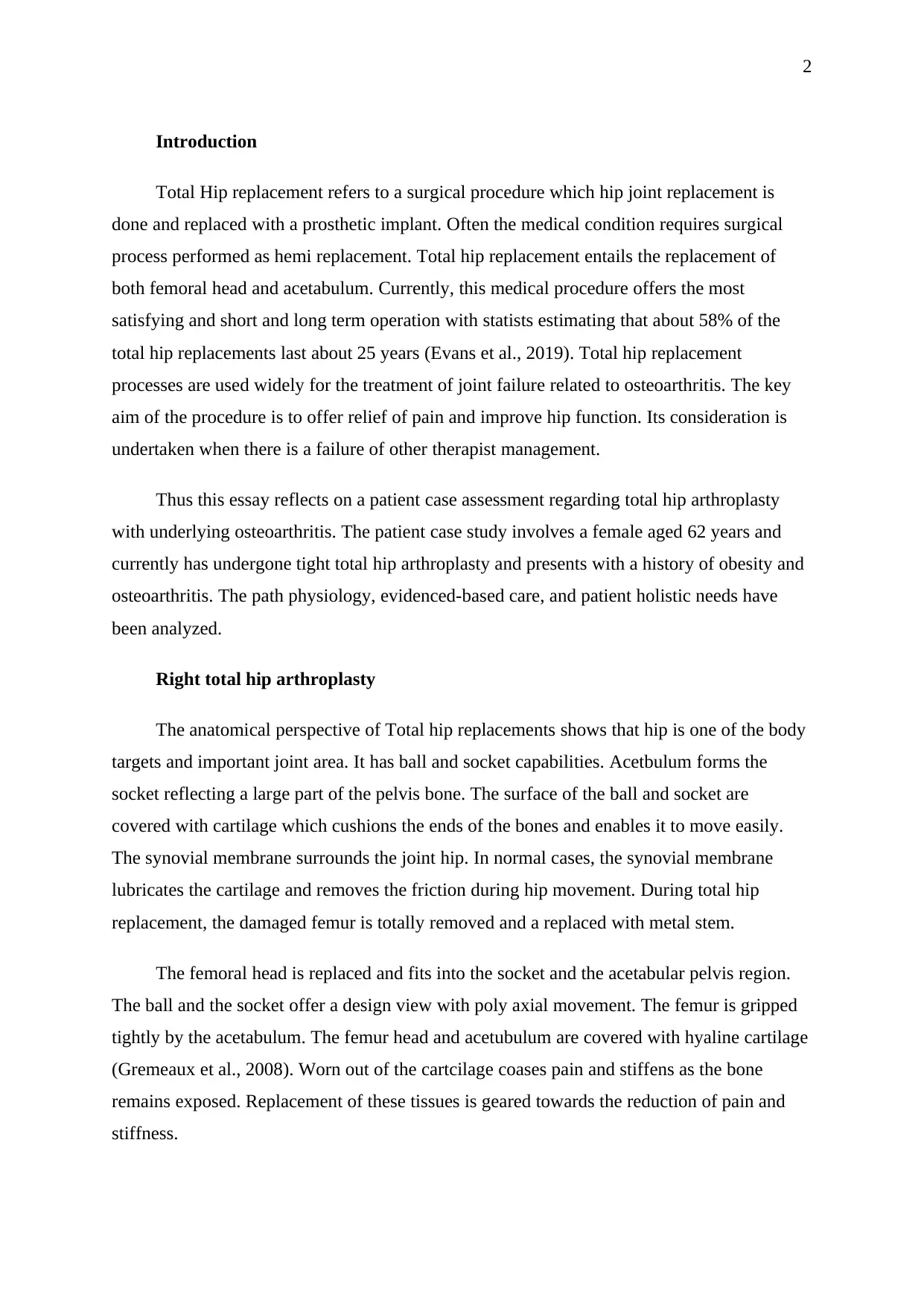
2
Introduction
Total Hip replacement refers to a surgical procedure which hip joint replacement is
done and replaced with a prosthetic implant. Often the medical condition requires surgical
process performed as hemi replacement. Total hip replacement entails the replacement of
both femoral head and acetabulum. Currently, this medical procedure offers the most
satisfying and short and long term operation with statists estimating that about 58% of the
total hip replacements last about 25 years (Evans et al., 2019). Total hip replacement
processes are used widely for the treatment of joint failure related to osteoarthritis. The key
aim of the procedure is to offer relief of pain and improve hip function. Its consideration is
undertaken when there is a failure of other therapist management.
Thus this essay reflects on a patient case assessment regarding total hip arthroplasty
with underlying osteoarthritis. The patient case study involves a female aged 62 years and
currently has undergone tight total hip arthroplasty and presents with a history of obesity and
osteoarthritis. The path physiology, evidenced-based care, and patient holistic needs have
been analyzed.
Right total hip arthroplasty
The anatomical perspective of Total hip replacements shows that hip is one of the body
targets and important joint area. It has ball and socket capabilities. Acetbulum forms the
socket reflecting a large part of the pelvis bone. The surface of the ball and socket are
covered with cartilage which cushions the ends of the bones and enables it to move easily.
The synovial membrane surrounds the joint hip. In normal cases, the synovial membrane
lubricates the cartilage and removes the friction during hip movement. During total hip
replacement, the damaged femur is totally removed and a replaced with metal stem.
The femoral head is replaced and fits into the socket and the acetabular pelvis region.
The ball and the socket offer a design view with poly axial movement. The femur is gripped
tightly by the acetabulum. The femur head and acetubulum are covered with hyaline cartilage
(Gremeaux et al., 2008). Worn out of the cartcilage coases pain and stiffens as the bone
remains exposed. Replacement of these tissues is geared towards the reduction of pain and
stiffness.
Introduction
Total Hip replacement refers to a surgical procedure which hip joint replacement is
done and replaced with a prosthetic implant. Often the medical condition requires surgical
process performed as hemi replacement. Total hip replacement entails the replacement of
both femoral head and acetabulum. Currently, this medical procedure offers the most
satisfying and short and long term operation with statists estimating that about 58% of the
total hip replacements last about 25 years (Evans et al., 2019). Total hip replacement
processes are used widely for the treatment of joint failure related to osteoarthritis. The key
aim of the procedure is to offer relief of pain and improve hip function. Its consideration is
undertaken when there is a failure of other therapist management.
Thus this essay reflects on a patient case assessment regarding total hip arthroplasty
with underlying osteoarthritis. The patient case study involves a female aged 62 years and
currently has undergone tight total hip arthroplasty and presents with a history of obesity and
osteoarthritis. The path physiology, evidenced-based care, and patient holistic needs have
been analyzed.
Right total hip arthroplasty
The anatomical perspective of Total hip replacements shows that hip is one of the body
targets and important joint area. It has ball and socket capabilities. Acetbulum forms the
socket reflecting a large part of the pelvis bone. The surface of the ball and socket are
covered with cartilage which cushions the ends of the bones and enables it to move easily.
The synovial membrane surrounds the joint hip. In normal cases, the synovial membrane
lubricates the cartilage and removes the friction during hip movement. During total hip
replacement, the damaged femur is totally removed and a replaced with metal stem.
The femoral head is replaced and fits into the socket and the acetabular pelvis region.
The ball and the socket offer a design view with poly axial movement. The femur is gripped
tightly by the acetabulum. The femur head and acetubulum are covered with hyaline cartilage
(Gremeaux et al., 2008). Worn out of the cartcilage coases pain and stiffens as the bone
remains exposed. Replacement of these tissues is geared towards the reduction of pain and
stiffness.

3
Etiology
Total hip replacement is performed frequently and selectively. Osteoporosis and
osteomalacia have been the most significant factors leading to the high incidence of hip
fractions. This is illustrated by the patient state of osteoporosis and obesity; further worsened
by patient age status as risks increases as age rises.
Osteoarthritis Pathophysiology
Primary and secondary osteoarthritis have shown bilateral symmetry. Traditional
osteoarthritis is often observed to case articular cartilage occurring on the synovial joints.
Inflammations occurring causes noninflammatory arthritis which is observed on cytokines
and metalloproteinases released to the joints. Early osteoarthritis causes swelling of the
cartilage and increases synthesis of proteoglycans which indicate effort of chondrocytes to
repair the cartilage damage. Progression of osteoarthritis leads to great loss of joint space
which contrasts with inflammatory arthritis. Cartilage erosion of the osteoarthritis progresses
until the underlying bone is exposed. This increases the stress on the biomedical strength of
the bone. The etiological pain on the joints, especially on weight-bearing regions on the hip,
can cause significant challenge to the patient (Kraeutler et al., 2017).
Clinical manifestations
The occurrence of osteoarthritis is often is low and occur over a long duration of time.
This leads to patient less activeness and more susceptible to morbidities thus decreasing
physical activity. Pain occurs on the initial morbidity sources with primary symptoms being
deep joint pain. There is an occurrence of reduced movement and physical activity and relive
can be sought from rests and response to simple analgesics. The joints can become unstable
with osteoarthritis progression thus pain become more prominent. Physical examination
depicts joints movements’ difficulty. Physical examination limits itself on the pain joints
affected regions. The progression of the disease takes place in three stages, the breakdown of
cartilage, fibrillation and breakdown of products (Krasnokutsky et al., 2017.
Evidence-based treatment care
Joint pain presents a prevalent musculoskeletal condition in osteoarthritis. Evidenced-
Etiology
Total hip replacement is performed frequently and selectively. Osteoporosis and
osteomalacia have been the most significant factors leading to the high incidence of hip
fractions. This is illustrated by the patient state of osteoporosis and obesity; further worsened
by patient age status as risks increases as age rises.
Osteoarthritis Pathophysiology
Primary and secondary osteoarthritis have shown bilateral symmetry. Traditional
osteoarthritis is often observed to case articular cartilage occurring on the synovial joints.
Inflammations occurring causes noninflammatory arthritis which is observed on cytokines
and metalloproteinases released to the joints. Early osteoarthritis causes swelling of the
cartilage and increases synthesis of proteoglycans which indicate effort of chondrocytes to
repair the cartilage damage. Progression of osteoarthritis leads to great loss of joint space
which contrasts with inflammatory arthritis. Cartilage erosion of the osteoarthritis progresses
until the underlying bone is exposed. This increases the stress on the biomedical strength of
the bone. The etiological pain on the joints, especially on weight-bearing regions on the hip,
can cause significant challenge to the patient (Kraeutler et al., 2017).
Clinical manifestations
The occurrence of osteoarthritis is often is low and occur over a long duration of time.
This leads to patient less activeness and more susceptible to morbidities thus decreasing
physical activity. Pain occurs on the initial morbidity sources with primary symptoms being
deep joint pain. There is an occurrence of reduced movement and physical activity and relive
can be sought from rests and response to simple analgesics. The joints can become unstable
with osteoarthritis progression thus pain become more prominent. Physical examination
depicts joints movements’ difficulty. Physical examination limits itself on the pain joints
affected regions. The progression of the disease takes place in three stages, the breakdown of
cartilage, fibrillation and breakdown of products (Krasnokutsky et al., 2017.
Evidence-based treatment care
Joint pain presents a prevalent musculoskeletal condition in osteoarthritis. Evidenced-
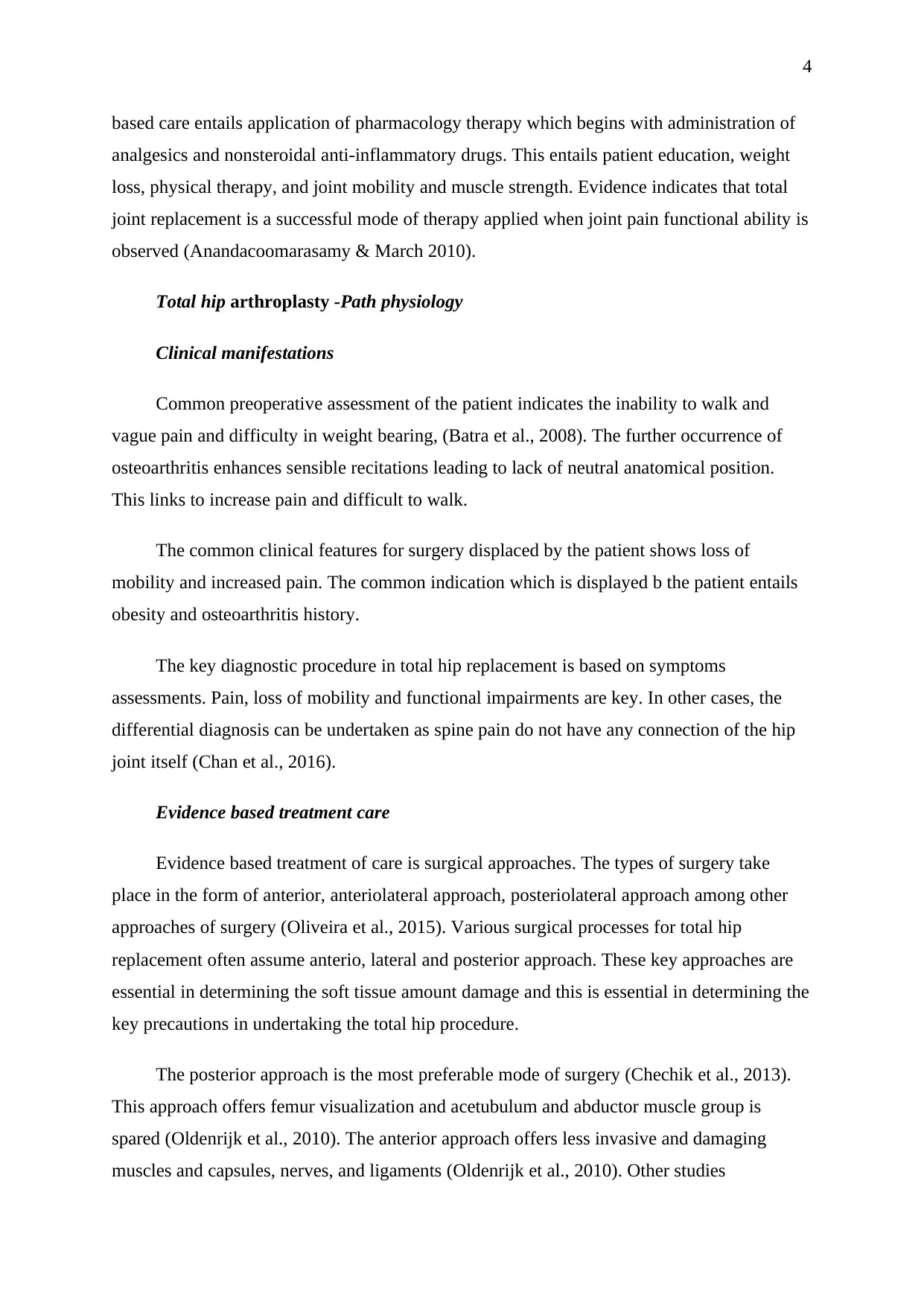
4
based care entails application of pharmacology therapy which begins with administration of
analgesics and nonsteroidal anti-inflammatory drugs. This entails patient education, weight
loss, physical therapy, and joint mobility and muscle strength. Evidence indicates that total
joint replacement is a successful mode of therapy applied when joint pain functional ability is
observed (Anandacoomarasamy & March 2010).
Total hip arthroplasty -Path physiology
Clinical manifestations
Common preoperative assessment of the patient indicates the inability to walk and
vague pain and difficulty in weight bearing, (Batra et al., 2008). The further occurrence of
osteoarthritis enhances sensible recitations leading to lack of neutral anatomical position.
This links to increase pain and difficult to walk.
The common clinical features for surgery displaced by the patient shows loss of
mobility and increased pain. The common indication which is displayed b the patient entails
obesity and osteoarthritis history.
The key diagnostic procedure in total hip replacement is based on symptoms
assessments. Pain, loss of mobility and functional impairments are key. In other cases, the
differential diagnosis can be undertaken as spine pain do not have any connection of the hip
joint itself (Chan et al., 2016).
Evidence based treatment care
Evidence based treatment of care is surgical approaches. The types of surgery take
place in the form of anterior, anteriolateral approach, posteriolateral approach among other
approaches of surgery (Oliveira et al., 2015). Various surgical processes for total hip
replacement often assume anterio, lateral and posterior approach. These key approaches are
essential in determining the soft tissue amount damage and this is essential in determining the
key precautions in undertaking the total hip procedure.
The posterior approach is the most preferable mode of surgery (Chechik et al., 2013).
This approach offers femur visualization and acetubulum and abductor muscle group is
spared (Oldenrijk et al., 2010). The anterior approach offers less invasive and damaging
muscles and capsules, nerves, and ligaments (Oldenrijk et al., 2010). Other studies
based care entails application of pharmacology therapy which begins with administration of
analgesics and nonsteroidal anti-inflammatory drugs. This entails patient education, weight
loss, physical therapy, and joint mobility and muscle strength. Evidence indicates that total
joint replacement is a successful mode of therapy applied when joint pain functional ability is
observed (Anandacoomarasamy & March 2010).
Total hip arthroplasty -Path physiology
Clinical manifestations
Common preoperative assessment of the patient indicates the inability to walk and
vague pain and difficulty in weight bearing, (Batra et al., 2008). The further occurrence of
osteoarthritis enhances sensible recitations leading to lack of neutral anatomical position.
This links to increase pain and difficult to walk.
The common clinical features for surgery displaced by the patient shows loss of
mobility and increased pain. The common indication which is displayed b the patient entails
obesity and osteoarthritis history.
The key diagnostic procedure in total hip replacement is based on symptoms
assessments. Pain, loss of mobility and functional impairments are key. In other cases, the
differential diagnosis can be undertaken as spine pain do not have any connection of the hip
joint itself (Chan et al., 2016).
Evidence based treatment care
Evidence based treatment of care is surgical approaches. The types of surgery take
place in the form of anterior, anteriolateral approach, posteriolateral approach among other
approaches of surgery (Oliveira et al., 2015). Various surgical processes for total hip
replacement often assume anterio, lateral and posterior approach. These key approaches are
essential in determining the soft tissue amount damage and this is essential in determining the
key precautions in undertaking the total hip procedure.
The posterior approach is the most preferable mode of surgery (Chechik et al., 2013).
This approach offers femur visualization and acetubulum and abductor muscle group is
spared (Oldenrijk et al., 2010). The anterior approach offers less invasive and damaging
muscles and capsules, nerves, and ligaments (Oldenrijk et al., 2010). Other studies
Secure Best Marks with AI Grader
Need help grading? Try our AI Grader for instant feedback on your assignments.
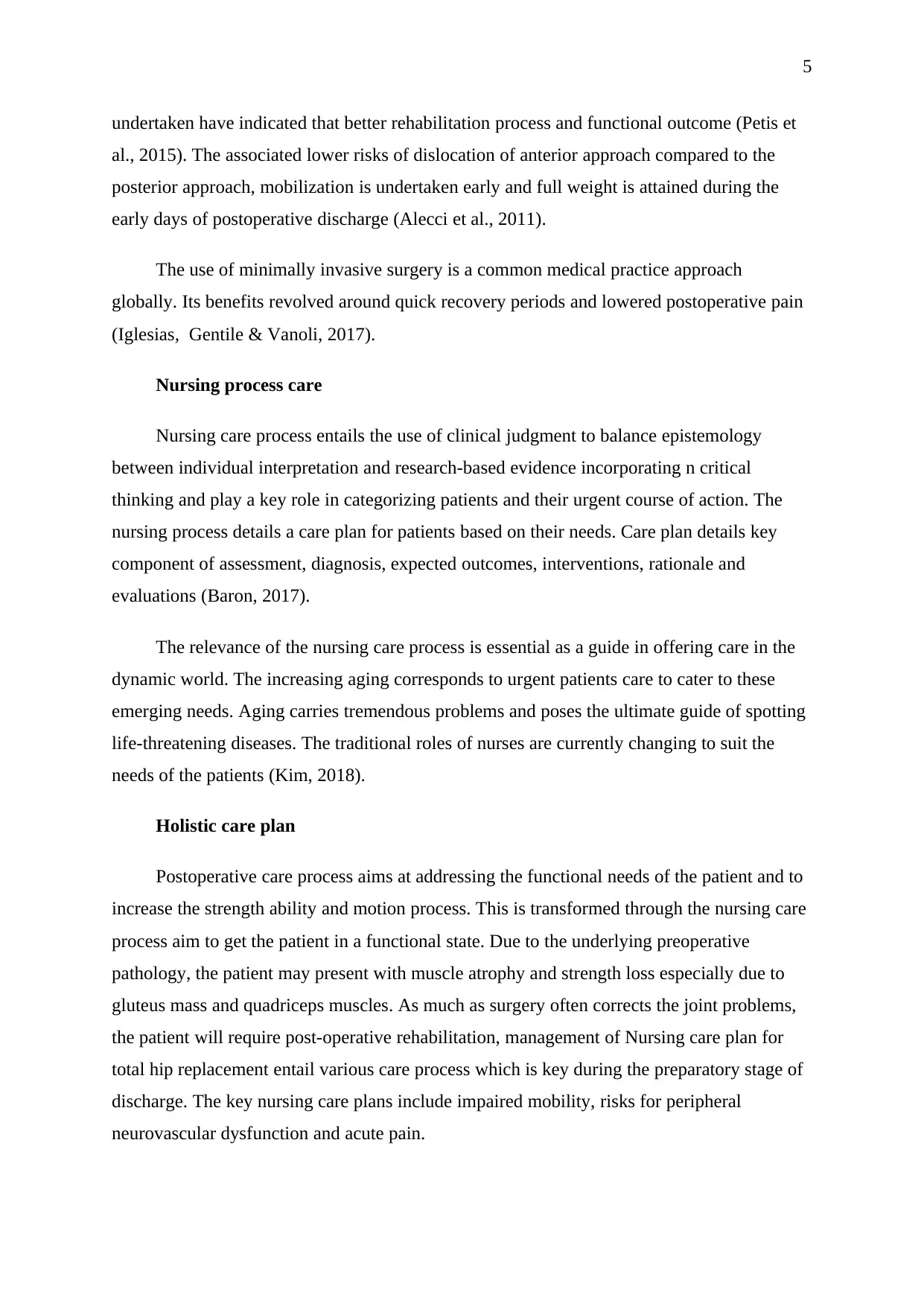
5
undertaken have indicated that better rehabilitation process and functional outcome (Petis et
al., 2015). The associated lower risks of dislocation of anterior approach compared to the
posterior approach, mobilization is undertaken early and full weight is attained during the
early days of postoperative discharge (Alecci et al., 2011).
The use of minimally invasive surgery is a common medical practice approach
globally. Its benefits revolved around quick recovery periods and lowered postoperative pain
(Iglesias, Gentile & Vanoli, 2017).
Nursing process care
Nursing care process entails the use of clinical judgment to balance epistemology
between individual interpretation and research-based evidence incorporating n critical
thinking and play a key role in categorizing patients and their urgent course of action. The
nursing process details a care plan for patients based on their needs. Care plan details key
component of assessment, diagnosis, expected outcomes, interventions, rationale and
evaluations (Baron, 2017).
The relevance of the nursing care process is essential as a guide in offering care in the
dynamic world. The increasing aging corresponds to urgent patients care to cater to these
emerging needs. Aging carries tremendous problems and poses the ultimate guide of spotting
life-threatening diseases. The traditional roles of nurses are currently changing to suit the
needs of the patients (Kim, 2018).
Holistic care plan
Postoperative care process aims at addressing the functional needs of the patient and to
increase the strength ability and motion process. This is transformed through the nursing care
process aim to get the patient in a functional state. Due to the underlying preoperative
pathology, the patient may present with muscle atrophy and strength loss especially due to
gluteus mass and quadriceps muscles. As much as surgery often corrects the joint problems,
the patient will require post-operative rehabilitation, management of Nursing care plan for
total hip replacement entail various care process which is key during the preparatory stage of
discharge. The key nursing care plans include impaired mobility, risks for peripheral
neurovascular dysfunction and acute pain.
undertaken have indicated that better rehabilitation process and functional outcome (Petis et
al., 2015). The associated lower risks of dislocation of anterior approach compared to the
posterior approach, mobilization is undertaken early and full weight is attained during the
early days of postoperative discharge (Alecci et al., 2011).
The use of minimally invasive surgery is a common medical practice approach
globally. Its benefits revolved around quick recovery periods and lowered postoperative pain
(Iglesias, Gentile & Vanoli, 2017).
Nursing process care
Nursing care process entails the use of clinical judgment to balance epistemology
between individual interpretation and research-based evidence incorporating n critical
thinking and play a key role in categorizing patients and their urgent course of action. The
nursing process details a care plan for patients based on their needs. Care plan details key
component of assessment, diagnosis, expected outcomes, interventions, rationale and
evaluations (Baron, 2017).
The relevance of the nursing care process is essential as a guide in offering care in the
dynamic world. The increasing aging corresponds to urgent patients care to cater to these
emerging needs. Aging carries tremendous problems and poses the ultimate guide of spotting
life-threatening diseases. The traditional roles of nurses are currently changing to suit the
needs of the patients (Kim, 2018).
Holistic care plan
Postoperative care process aims at addressing the functional needs of the patient and to
increase the strength ability and motion process. This is transformed through the nursing care
process aim to get the patient in a functional state. Due to the underlying preoperative
pathology, the patient may present with muscle atrophy and strength loss especially due to
gluteus mass and quadriceps muscles. As much as surgery often corrects the joint problems,
the patient will require post-operative rehabilitation, management of Nursing care plan for
total hip replacement entail various care process which is key during the preparatory stage of
discharge. The key nursing care plans include impaired mobility, risks for peripheral
neurovascular dysfunction and acute pain.
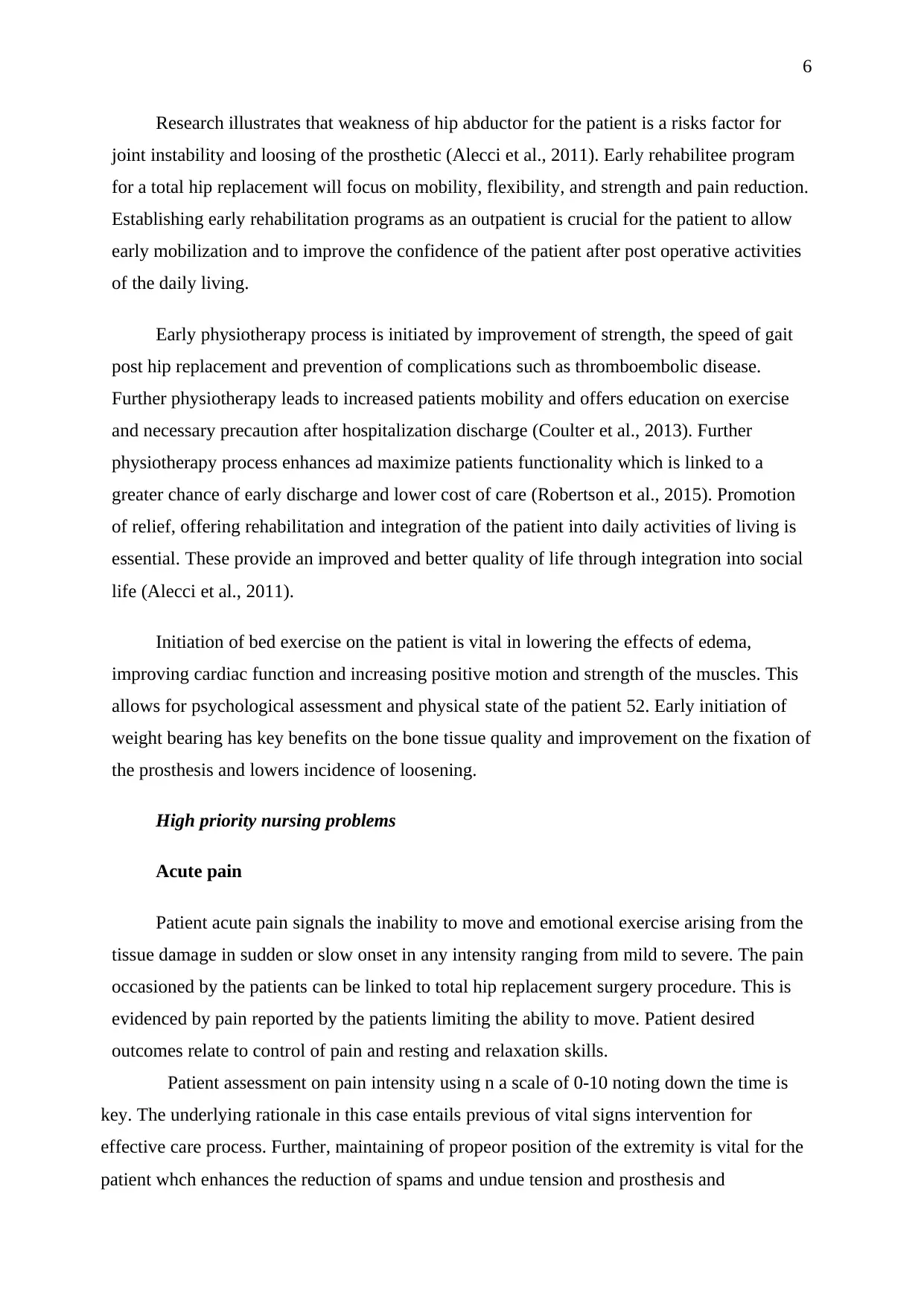
6
Research illustrates that weakness of hip abductor for the patient is a risks factor for
joint instability and loosing of the prosthetic (Alecci et al., 2011). Early rehabilitee program
for a total hip replacement will focus on mobility, flexibility, and strength and pain reduction.
Establishing early rehabilitation programs as an outpatient is crucial for the patient to allow
early mobilization and to improve the confidence of the patient after post operative activities
of the daily living.
Early physiotherapy process is initiated by improvement of strength, the speed of gait
post hip replacement and prevention of complications such as thromboembolic disease.
Further physiotherapy leads to increased patients mobility and offers education on exercise
and necessary precaution after hospitalization discharge (Coulter et al., 2013). Further
physiotherapy process enhances ad maximize patients functionality which is linked to a
greater chance of early discharge and lower cost of care (Robertson et al., 2015). Promotion
of relief, offering rehabilitation and integration of the patient into daily activities of living is
essential. These provide an improved and better quality of life through integration into social
life (Alecci et al., 2011).
Initiation of bed exercise on the patient is vital in lowering the effects of edema,
improving cardiac function and increasing positive motion and strength of the muscles. This
allows for psychological assessment and physical state of the patient 52. Early initiation of
weight bearing has key benefits on the bone tissue quality and improvement on the fixation of
the prosthesis and lowers incidence of loosening.
High priority nursing problems
Acute pain
Patient acute pain signals the inability to move and emotional exercise arising from the
tissue damage in sudden or slow onset in any intensity ranging from mild to severe. The pain
occasioned by the patients can be linked to total hip replacement surgery procedure. This is
evidenced by pain reported by the patients limiting the ability to move. Patient desired
outcomes relate to control of pain and resting and relaxation skills.
Patient assessment on pain intensity using n a scale of 0-10 noting down the time is
key. The underlying rationale in this case entails previous of vital signs intervention for
effective care process. Further, maintaining of propeor position of the extremity is vital for the
patient whch enhances the reduction of spams and undue tension and prosthesis and
Research illustrates that weakness of hip abductor for the patient is a risks factor for
joint instability and loosing of the prosthetic (Alecci et al., 2011). Early rehabilitee program
for a total hip replacement will focus on mobility, flexibility, and strength and pain reduction.
Establishing early rehabilitation programs as an outpatient is crucial for the patient to allow
early mobilization and to improve the confidence of the patient after post operative activities
of the daily living.
Early physiotherapy process is initiated by improvement of strength, the speed of gait
post hip replacement and prevention of complications such as thromboembolic disease.
Further physiotherapy leads to increased patients mobility and offers education on exercise
and necessary precaution after hospitalization discharge (Coulter et al., 2013). Further
physiotherapy process enhances ad maximize patients functionality which is linked to a
greater chance of early discharge and lower cost of care (Robertson et al., 2015). Promotion
of relief, offering rehabilitation and integration of the patient into daily activities of living is
essential. These provide an improved and better quality of life through integration into social
life (Alecci et al., 2011).
Initiation of bed exercise on the patient is vital in lowering the effects of edema,
improving cardiac function and increasing positive motion and strength of the muscles. This
allows for psychological assessment and physical state of the patient 52. Early initiation of
weight bearing has key benefits on the bone tissue quality and improvement on the fixation of
the prosthesis and lowers incidence of loosening.
High priority nursing problems
Acute pain
Patient acute pain signals the inability to move and emotional exercise arising from the
tissue damage in sudden or slow onset in any intensity ranging from mild to severe. The pain
occasioned by the patients can be linked to total hip replacement surgery procedure. This is
evidenced by pain reported by the patients limiting the ability to move. Patient desired
outcomes relate to control of pain and resting and relaxation skills.
Patient assessment on pain intensity using n a scale of 0-10 noting down the time is
key. The underlying rationale in this case entails previous of vital signs intervention for
effective care process. Further, maintaining of propeor position of the extremity is vital for the
patient whch enhances the reduction of spams and undue tension and prosthesis and

7
surrounding tissues. Provision of comfort measures such as back rub and frequent
repositioning and encourage stress management techniques and providing therapeutic touch,
this is key in reducing the tension of the muscle and promoting a sense of control and enhance
coping abilities in the management of pain. Administration of drugs such as narcotics, muscle
relaxants and analgesiscs is key for the patient. This will aid in reducing muscle spasm and
tension which ensures the overall contribution of tension. (Chechi et al., 2013).
Risk of peripheral Neurovascular dysfunction
This is associated with compromised patient state and often occasioned by the
decreased sensation of the patient, numbness, and tingling. The desired patient outcomes are
evidenced by sensation and movements within short limits. This will demonstrate adequate
tissue perfusion.
Key nursing intervention entails evaluation of palpation on both sides which ensures
capillary refill and maintenance of color and temperature. Relevant rationale entail undertaking
this process is related to diminished refill time, further comparing with unoperated limb offers
clues on the neurovascular problem generalization. Enhancing stabilization and the patient is in
the correct position and no undue pressure being exerted. This can be indicative of hematoma
formation which potentiates through neurovascular compromise. Undertaking observation
intervention of continued bleeding and oozing of a site and mucous membrane is key for the
pateint. Depression of clotting mechanism and sensitivity to anti coagulants often result in
bleeding occurrences which can lead to low blood level. (Chechi et al.,2013).
Impaired physical mobility
Impaired physical mobility leads to limited independence and purposeful movement
of the body. This is evidenced by the patient inability to engage in movement, pain occurrence
and decreased level of wound strength. The desired patient outcomes are to maintain a
functional position and for the patient to display function and strength. Maintenance of
affected joint in a prescribed position and aligning well in bed, key rationale entail ensuring
stabilization and reduces the risks of injury during the recovery phase of the analgesics. Aiding
the patient in a range of motion exercise is fundamental. Degenerative joint disease can lead to
loss of joint function during movements due to restricted movements.
Holistic care needs
Holistic Assesment of the patient social, physical emotional, psychological, cultural and
surrounding tissues. Provision of comfort measures such as back rub and frequent
repositioning and encourage stress management techniques and providing therapeutic touch,
this is key in reducing the tension of the muscle and promoting a sense of control and enhance
coping abilities in the management of pain. Administration of drugs such as narcotics, muscle
relaxants and analgesiscs is key for the patient. This will aid in reducing muscle spasm and
tension which ensures the overall contribution of tension. (Chechi et al., 2013).
Risk of peripheral Neurovascular dysfunction
This is associated with compromised patient state and often occasioned by the
decreased sensation of the patient, numbness, and tingling. The desired patient outcomes are
evidenced by sensation and movements within short limits. This will demonstrate adequate
tissue perfusion.
Key nursing intervention entails evaluation of palpation on both sides which ensures
capillary refill and maintenance of color and temperature. Relevant rationale entail undertaking
this process is related to diminished refill time, further comparing with unoperated limb offers
clues on the neurovascular problem generalization. Enhancing stabilization and the patient is in
the correct position and no undue pressure being exerted. This can be indicative of hematoma
formation which potentiates through neurovascular compromise. Undertaking observation
intervention of continued bleeding and oozing of a site and mucous membrane is key for the
pateint. Depression of clotting mechanism and sensitivity to anti coagulants often result in
bleeding occurrences which can lead to low blood level. (Chechi et al.,2013).
Impaired physical mobility
Impaired physical mobility leads to limited independence and purposeful movement
of the body. This is evidenced by the patient inability to engage in movement, pain occurrence
and decreased level of wound strength. The desired patient outcomes are to maintain a
functional position and for the patient to display function and strength. Maintenance of
affected joint in a prescribed position and aligning well in bed, key rationale entail ensuring
stabilization and reduces the risks of injury during the recovery phase of the analgesics. Aiding
the patient in a range of motion exercise is fundamental. Degenerative joint disease can lead to
loss of joint function during movements due to restricted movements.
Holistic care needs
Holistic Assesment of the patient social, physical emotional, psychological, cultural and
Paraphrase This Document
Need a fresh take? Get an instant paraphrase of this document with our AI Paraphraser
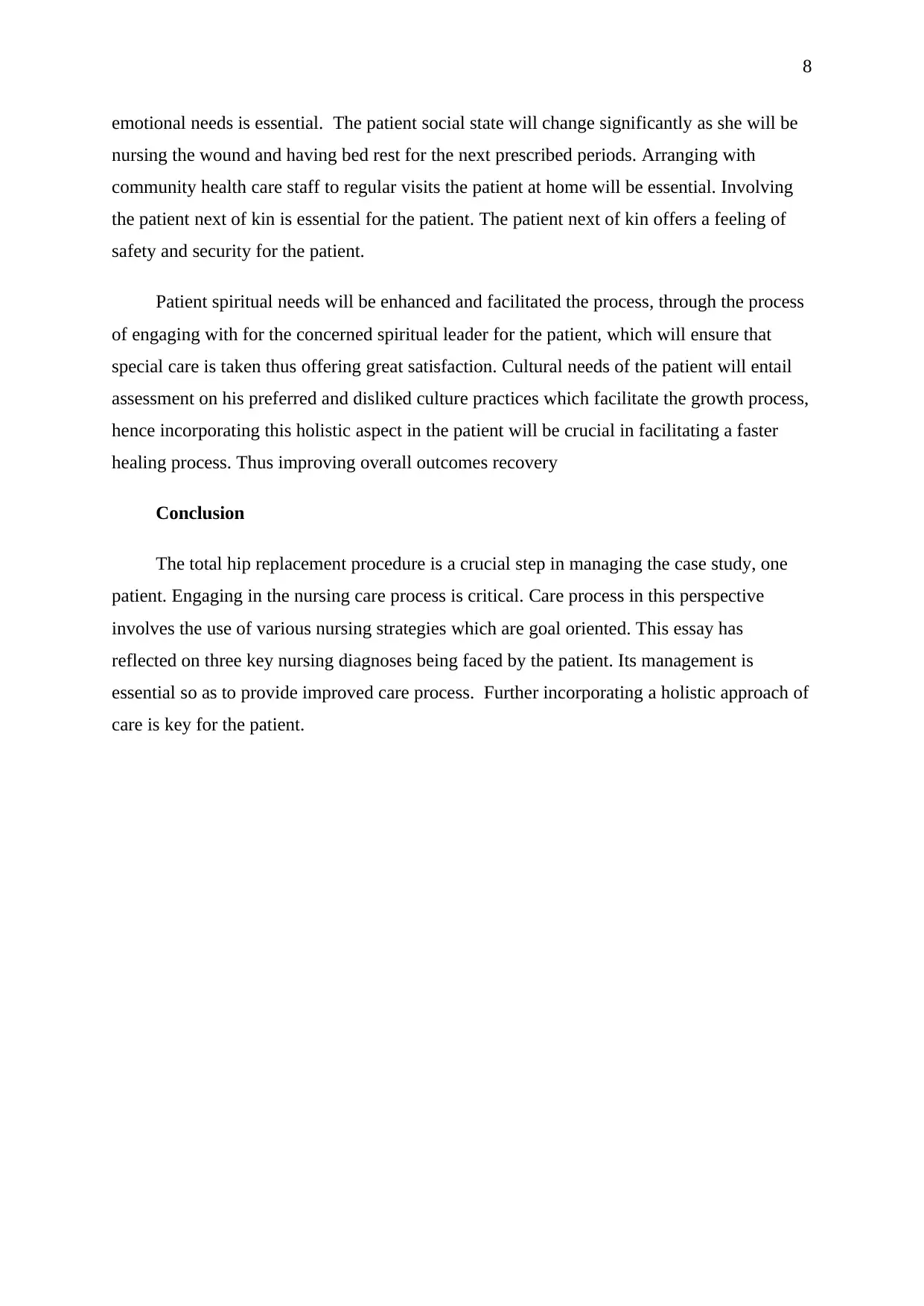
8
emotional needs is essential. The patient social state will change significantly as she will be
nursing the wound and having bed rest for the next prescribed periods. Arranging with
community health care staff to regular visits the patient at home will be essential. Involving
the patient next of kin is essential for the patient. The patient next of kin offers a feeling of
safety and security for the patient.
Patient spiritual needs will be enhanced and facilitated the process, through the process
of engaging with for the concerned spiritual leader for the patient, which will ensure that
special care is taken thus offering great satisfaction. Cultural needs of the patient will entail
assessment on his preferred and disliked culture practices which facilitate the growth process,
hence incorporating this holistic aspect in the patient will be crucial in facilitating a faster
healing process. Thus improving overall outcomes recovery
Conclusion
The total hip replacement procedure is a crucial step in managing the case study, one
patient. Engaging in the nursing care process is critical. Care process in this perspective
involves the use of various nursing strategies which are goal oriented. This essay has
reflected on three key nursing diagnoses being faced by the patient. Its management is
essential so as to provide improved care process. Further incorporating a holistic approach of
care is key for the patient.
emotional needs is essential. The patient social state will change significantly as she will be
nursing the wound and having bed rest for the next prescribed periods. Arranging with
community health care staff to regular visits the patient at home will be essential. Involving
the patient next of kin is essential for the patient. The patient next of kin offers a feeling of
safety and security for the patient.
Patient spiritual needs will be enhanced and facilitated the process, through the process
of engaging with for the concerned spiritual leader for the patient, which will ensure that
special care is taken thus offering great satisfaction. Cultural needs of the patient will entail
assessment on his preferred and disliked culture practices which facilitate the growth process,
hence incorporating this holistic aspect in the patient will be crucial in facilitating a faster
healing process. Thus improving overall outcomes recovery
Conclusion
The total hip replacement procedure is a crucial step in managing the case study, one
patient. Engaging in the nursing care process is critical. Care process in this perspective
involves the use of various nursing strategies which are goal oriented. This essay has
reflected on three key nursing diagnoses being faced by the patient. Its management is
essential so as to provide improved care process. Further incorporating a holistic approach of
care is key for the patient.
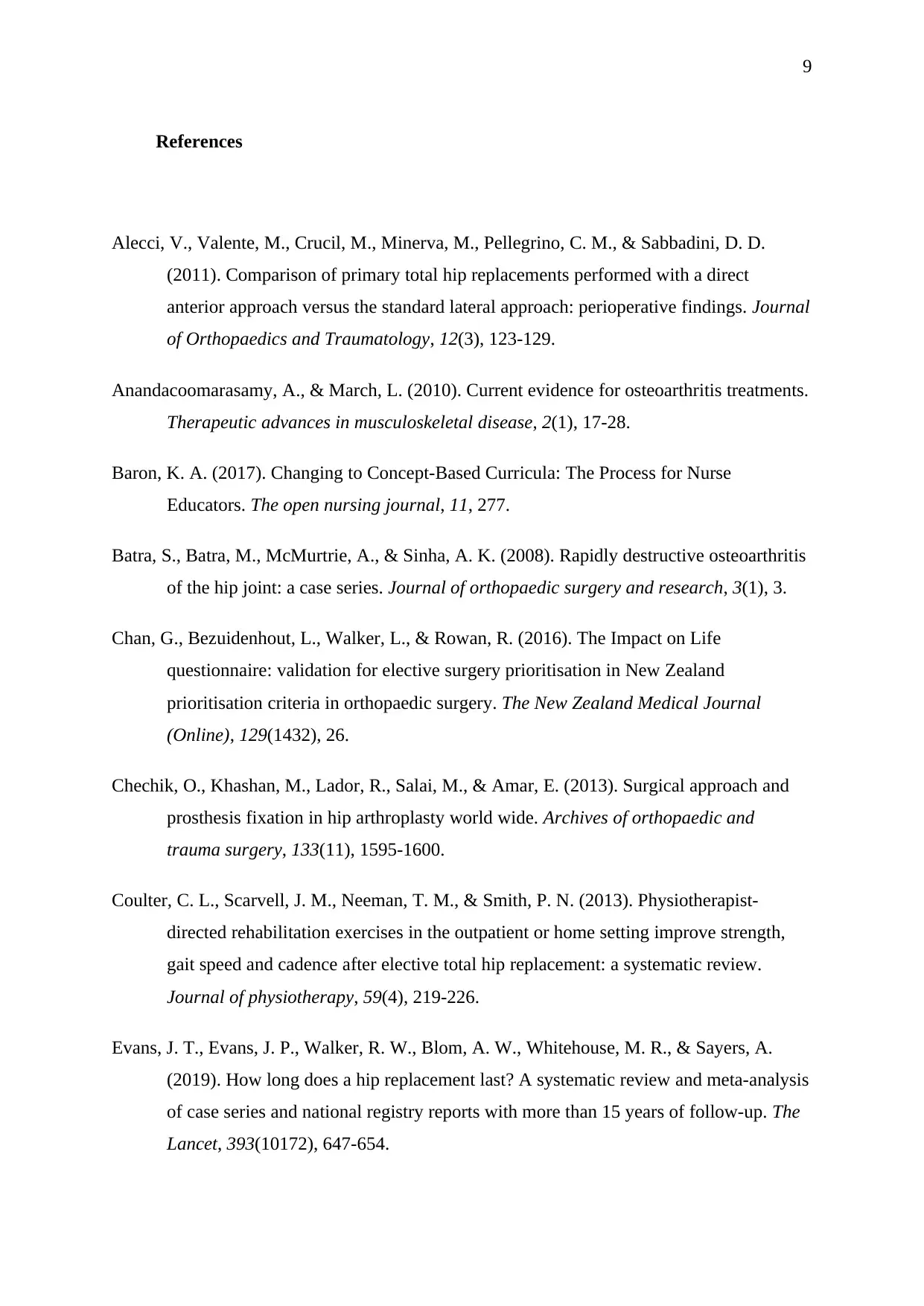
9
References
Alecci, V., Valente, M., Crucil, M., Minerva, M., Pellegrino, C. M., & Sabbadini, D. D.
(2011). Comparison of primary total hip replacements performed with a direct
anterior approach versus the standard lateral approach: perioperative findings. Journal
of Orthopaedics and Traumatology, 12(3), 123-129.
Anandacoomarasamy, A., & March, L. (2010). Current evidence for osteoarthritis treatments.
Therapeutic advances in musculoskeletal disease, 2(1), 17-28.
Baron, K. A. (2017). Changing to Concept-Based Curricula: The Process for Nurse
Educators. The open nursing journal, 11, 277.
Batra, S., Batra, M., McMurtrie, A., & Sinha, A. K. (2008). Rapidly destructive osteoarthritis
of the hip joint: a case series. Journal of orthopaedic surgery and research, 3(1), 3.
Chan, G., Bezuidenhout, L., Walker, L., & Rowan, R. (2016). The Impact on Life
questionnaire: validation for elective surgery prioritisation in New Zealand
prioritisation criteria in orthopaedic surgery. The New Zealand Medical Journal
(Online), 129(1432), 26.
Chechik, O., Khashan, M., Lador, R., Salai, M., & Amar, E. (2013). Surgical approach and
prosthesis fixation in hip arthroplasty world wide. Archives of orthopaedic and
trauma surgery, 133(11), 1595-1600.
Coulter, C. L., Scarvell, J. M., Neeman, T. M., & Smith, P. N. (2013). Physiotherapist-
directed rehabilitation exercises in the outpatient or home setting improve strength,
gait speed and cadence after elective total hip replacement: a systematic review.
Journal of physiotherapy, 59(4), 219-226.
Evans, J. T., Evans, J. P., Walker, R. W., Blom, A. W., Whitehouse, M. R., & Sayers, A.
(2019). How long does a hip replacement last? A systematic review and meta-analysis
of case series and national registry reports with more than 15 years of follow-up. The
Lancet, 393(10172), 647-654.
References
Alecci, V., Valente, M., Crucil, M., Minerva, M., Pellegrino, C. M., & Sabbadini, D. D.
(2011). Comparison of primary total hip replacements performed with a direct
anterior approach versus the standard lateral approach: perioperative findings. Journal
of Orthopaedics and Traumatology, 12(3), 123-129.
Anandacoomarasamy, A., & March, L. (2010). Current evidence for osteoarthritis treatments.
Therapeutic advances in musculoskeletal disease, 2(1), 17-28.
Baron, K. A. (2017). Changing to Concept-Based Curricula: The Process for Nurse
Educators. The open nursing journal, 11, 277.
Batra, S., Batra, M., McMurtrie, A., & Sinha, A. K. (2008). Rapidly destructive osteoarthritis
of the hip joint: a case series. Journal of orthopaedic surgery and research, 3(1), 3.
Chan, G., Bezuidenhout, L., Walker, L., & Rowan, R. (2016). The Impact on Life
questionnaire: validation for elective surgery prioritisation in New Zealand
prioritisation criteria in orthopaedic surgery. The New Zealand Medical Journal
(Online), 129(1432), 26.
Chechik, O., Khashan, M., Lador, R., Salai, M., & Amar, E. (2013). Surgical approach and
prosthesis fixation in hip arthroplasty world wide. Archives of orthopaedic and
trauma surgery, 133(11), 1595-1600.
Coulter, C. L., Scarvell, J. M., Neeman, T. M., & Smith, P. N. (2013). Physiotherapist-
directed rehabilitation exercises in the outpatient or home setting improve strength,
gait speed and cadence after elective total hip replacement: a systematic review.
Journal of physiotherapy, 59(4), 219-226.
Evans, J. T., Evans, J. P., Walker, R. W., Blom, A. W., Whitehouse, M. R., & Sayers, A.
(2019). How long does a hip replacement last? A systematic review and meta-analysis
of case series and national registry reports with more than 15 years of follow-up. The
Lancet, 393(10172), 647-654.

10
Gremeaux, V., Renault, J., Pardon, L., Deley, G., Lepers, R., & Casillas, J. M. (2008). Low-
frequency electric muscle stimulation combined with physical therapy after total hip
arthroplasty for hip osteoarthritis in elderly patients: a randomized controlled trial.
Archives of physical medicine and rehabilitation, 89(12), 2265-2273.
Iglesias, S. L., Gentile, L., & Vanoli, F. (2017). Femoral neck fractures in the elderly: from
risk factors to pronostic features for survival. J Trauma Crit Care. 2017; 1 (1): 16-21
J Trauma Crit Care 2017 Volume 1 Issue, 1, 2010-2015.
Kim, S. H., Choi, Y., Lee, J. H., Jang, D. E., & Kim, S. (2018). A Review of Trend of
Nursing Theories related Caregivers in Korea. The open nursing journal, 12, 26.
Kraeutler, M. J., Mitchell, J. J., Chahla, J., McCarty, E. C., & Pascual-Garrido, C. (2017).
Intra-articular implantation of mesenchymal stem cells, part 1: a review of the
literature for prevention of postmeniscectomy osteoarthritis. Orthopaedic journal of
sports medicine, 5(1), 2325967116680815
Krasnokutsky, S., Oshinsky, C., Attur, M., Ma, S., Zhou, H., Zheng, F., ... & Regatte, R.
(2017). Serum Urate Levels Predict Joint Space Narrowing in Non‐Gout Patients
With Medial Knee Osteoarthritis. Arthritis & rheumatology, 69(6), 1213-1220.
Oldenrijk, J. V., Hoogland, P. V., Tuijthof, G. J., Corveleijn, R., Noordenbos, T. W., &
Schafroth, M. U. (2010). Soft tissue damage after minimally invasive THA. Acta
Orthopaedica 2010; 81 (6): 696-702
Petis, S., Howard, J. L., Lanting, B. L., & Vasarhelyi, E. M. (2015). Surgical approach in
primary total hip arthroplasty: anatomy, technique and clinical outcomes. Canadian
Journal of Surgery, 58(2), 128.
Robertson, N. B., Warganich, T., Ghazarossian, J., & Khatod, M. (2015). Implementation of
an accelerated rehabilitation protocol for total joint arthroplasty in the managed care
setting: the experience of one institution. Advances in Orthopedic Surgery, 2015.
Gremeaux, V., Renault, J., Pardon, L., Deley, G., Lepers, R., & Casillas, J. M. (2008). Low-
frequency electric muscle stimulation combined with physical therapy after total hip
arthroplasty for hip osteoarthritis in elderly patients: a randomized controlled trial.
Archives of physical medicine and rehabilitation, 89(12), 2265-2273.
Iglesias, S. L., Gentile, L., & Vanoli, F. (2017). Femoral neck fractures in the elderly: from
risk factors to pronostic features for survival. J Trauma Crit Care. 2017; 1 (1): 16-21
J Trauma Crit Care 2017 Volume 1 Issue, 1, 2010-2015.
Kim, S. H., Choi, Y., Lee, J. H., Jang, D. E., & Kim, S. (2018). A Review of Trend of
Nursing Theories related Caregivers in Korea. The open nursing journal, 12, 26.
Kraeutler, M. J., Mitchell, J. J., Chahla, J., McCarty, E. C., & Pascual-Garrido, C. (2017).
Intra-articular implantation of mesenchymal stem cells, part 1: a review of the
literature for prevention of postmeniscectomy osteoarthritis. Orthopaedic journal of
sports medicine, 5(1), 2325967116680815
Krasnokutsky, S., Oshinsky, C., Attur, M., Ma, S., Zhou, H., Zheng, F., ... & Regatte, R.
(2017). Serum Urate Levels Predict Joint Space Narrowing in Non‐Gout Patients
With Medial Knee Osteoarthritis. Arthritis & rheumatology, 69(6), 1213-1220.
Oldenrijk, J. V., Hoogland, P. V., Tuijthof, G. J., Corveleijn, R., Noordenbos, T. W., &
Schafroth, M. U. (2010). Soft tissue damage after minimally invasive THA. Acta
Orthopaedica 2010; 81 (6): 696-702
Petis, S., Howard, J. L., Lanting, B. L., & Vasarhelyi, E. M. (2015). Surgical approach in
primary total hip arthroplasty: anatomy, technique and clinical outcomes. Canadian
Journal of Surgery, 58(2), 128.
Robertson, N. B., Warganich, T., Ghazarossian, J., & Khatod, M. (2015). Implementation of
an accelerated rehabilitation protocol for total joint arthroplasty in the managed care
setting: the experience of one institution. Advances in Orthopedic Surgery, 2015.
Secure Best Marks with AI Grader
Need help grading? Try our AI Grader for instant feedback on your assignments.

11
1 out of 11
Related Documents
Your All-in-One AI-Powered Toolkit for Academic Success.
+13062052269
info@desklib.com
Available 24*7 on WhatsApp / Email
![[object Object]](/_next/static/media/star-bottom.7253800d.svg)
Unlock your academic potential
© 2024 | Zucol Services PVT LTD | All rights reserved.





